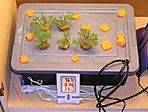Learningfirst
Member
Hey all,
I was just wondering if anyone else has had as many failed clone attempts as myself. Of course I've read so many of the tutorials both from JJ here, and in books and all over.
I guess I am just having shitty luck. Or perhaps I should buy some super-thrive or a bucket and try some of the more difficult looking cloning techniques. I guess I"m just curious about the experienced folk out there & if they may have had a lot of fails before the wins?
Peace.
Cool Poll results. I am pleased with a count vote population of nearly 20 members! Does show that dope doesn't make you dopey! Also; I'm certainly not alone in a quest to find the cloning technique. I have learned from this experiment and the knowledge of all those involved, that that best method to dial it in with cloning:" s to simply experiment and find what works best for you. There are several well informed tutorials so don't stop experimenting!" as written by the rock stars here on I.C. I raise my doob to everyone who contributes and those to come."
Peace.
I was just wondering if anyone else has had as many failed clone attempts as myself. Of course I've read so many of the tutorials both from JJ here, and in books and all over.
I guess I am just having shitty luck. Or perhaps I should buy some super-thrive or a bucket and try some of the more difficult looking cloning techniques. I guess I"m just curious about the experienced folk out there & if they may have had a lot of fails before the wins?
Peace.

Cool Poll results. I am pleased with a count vote population of nearly 20 members! Does show that dope doesn't make you dopey! Also; I'm certainly not alone in a quest to find the cloning technique. I have learned from this experiment and the knowledge of all those involved, that that best method to dial it in with cloning:" s to simply experiment and find what works best for you. There are several well informed tutorials so don't stop experimenting!" as written by the rock stars here on I.C. I raise my doob to everyone who contributes and those to come."
Peace.
Last edited:










